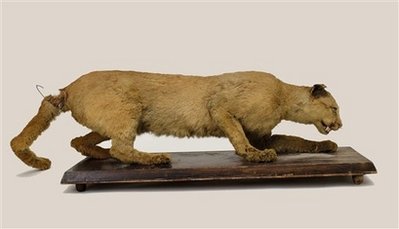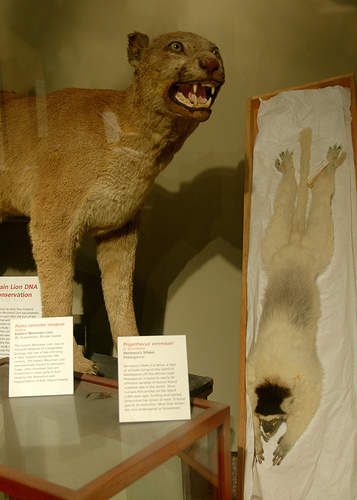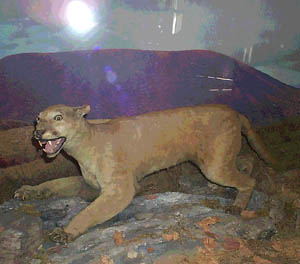
March 3, 2011

The declarations from the United States government are rather clear. In summary, on March 2, 2011, the U.S. Fish and Wildlife Service, in essence and reality, told the people of the United States the following:
Your sightings of the Eastern subspecies of the mountain lion (Puma concolor couguar) have been dismissed.
Your investigations of the existence of the Eastern panther (Puma concolor couguar) have been a waste of your time.
Your findings of footprints and other solid evidence of the Eastern cougar (Puma concolor couguar) are incorrect.
On Wednesday, the United States Fish and Wildlife Service “declared the eastern cougar to be extinct, confirming a widely held belief among wildlife biologists that native populations of the big cat were wiped out by man a century ago. After a lengthy review, federal officials concluded there are no breeding populations of cougars — also known as pumas, panthers, mountain lions and catamounts — in the eastern United States. Researchers believe the eastern cougar subspecies has probably been extinct since the 1930s,” reported Michael Rubinkam for the Associated Press. “Wednesday’s declaration paves the way for the eastern cougar to be removed from the endangered species list, where it was placed in 1973.”
“During the review, the Service received 573 responses to a request for scientific information about the possible existence of the eastern cougar subspecies; conducted an extensive review of U.S. and Canadian scientific literature; and requested information from the 21 States within the historical range of the subspecies,” noted the U.S. Fish and Wildlife Service.

This is said to be the last Eastern cougar to have existed in Pennsylvania; it was killed in Pennsylvania in 1874 by Thomas Anson. The felid was formerly part of the collection of Henry Shoemaker. Photo: State Museum of Pennsylvania, Pennsylvania Historical and Museum Commission, 2006.
The government’s findings does not effect the Florida panther, which is considered to be another subspecies (Puma concolor coryi). Though the Florida panther once ranged throughout the Southeast, it now exists in less than five percent of its historic habitat and in only one breeding population of 120 to 160 animals in southwestern Florida.
The wildlife service confirmed 108 sightings of supposed Eastern panthers (Puma concolor couguar) between 1900 and 2010, but noted that these animals, they said, were not Puma concolor couguar but instead were “either escaped or were released from captivity, or migrated from western states to the Midwest.”
The exact wording of the government news release stated: “Reports of [Eastern] cougars observed in the wild examined during the review process described cougars of other subspecies, often South American subspecies, that had been held in captivity and had escaped or been released to the wild, as well as wild cougars of the western United States subspecies that had migrated eastward to the Midwest.”

Eastern mountain lion, Harvard Museum of Natural History, Boston, Massachusetts. Photo: Curious Expedition, 2009.
Mark McCollough, an endangered species biologist who led the agency’s eastern cougar study, said that the last wild Eastern cougar was believed to have been killed in Maine in 1938.
Case closed? It appears the government wants us to think as much. They want you to stop all actions to prove there are any populations left in the East. They wish to have the debate ended.
No more “spotted owl syndrome” worries for developers and forest owners out East? No more funding needs for Eastern panther research?
Or is there something more deeply going on?
What might be the next focus of the government if they tell us that such and such species are no longer there?
We have to look no further than some recent historical information.
The politics of this declaration clearly pitted the 5-year-old private, well-funded, government-linked Eastern Cougar Foundation, recently renamed the Cougar Rewilding Foundation, against the 42-year-old grassroots, poorly-funded, nongovernmental Eastern Puma Research Network. The shift in focus of the ECF to reintroducing mountain lions into their alleged former ranges in the East vs the EPRN’s desire to provide proof of the still-established Eastern panther may foreshadow a policy of the U.S. Fish and Wildlife Service.
All future sightings of large, tan, deer-colored felids in the Eastern USA now will again exist in that shadowy zoological limbo occupied by the Ivory-billed woodpecker and Bigfoot. The Eastern panther has regained firm footing, anew, as a full-fledged cryptid. But it won’t matter, if mountain lions are reintroduced into the old ranges, and the picture gets messy and confusing, now will it?

Eastern panther as a museum specimen, this one from Pennsylvania, and the original Nittany Lion, apparently or probably not. Photo: Dave Bonta, apparently.
About Loren Coleman
Loren Coleman is one of the world’s leading cryptozoologists, some say “the” leading living cryptozoologist. Certainly, he is acknowledged as the current living American researcher and writer who has most popularized cryptozoology in the late 20th and early 21st centuries.
Starting his fieldwork and investigations in 1960, after traveling and trekking extensively in pursuit of cryptozoological mysteries, Coleman began writing to share his experiences in 1969. An honorary member of Ivan T. Sanderson’s Society for the Investigation of the Unexplained in the 1970s, Coleman has been bestowed with similar honorary memberships of the North Idaho College Cryptozoology Club in 1983, and in subsequent years, that of the British Columbia Scientific Cryptozoology Club, CryptoSafari International, and other international organizations. He was also a Life Member and Benefactor of the International Society of Cryptozoology (now-defunct).
Loren Coleman’s daily blog, as a member of the Cryptomundo Team, served as an ongoing avenue of communication for the ever-growing body of cryptozoo news from 2005 through 2013. He returned as an infrequent contributor beginning Halloween week of 2015.
Coleman is the founder in 2003, and current director of the International Cryptozoology Museum in Portland, Maine.
Filed under Alien Big Cats, Breaking News, Cryptomundo Exclusive, CryptoZoo News, Cryptozoologists, Cryptozoology, Eyewitness Accounts, Mystery Cats, New Species